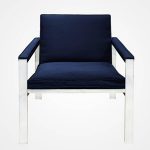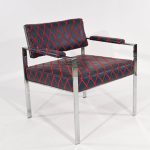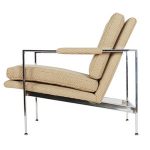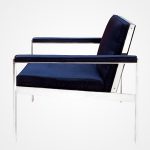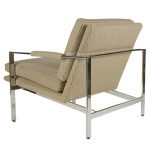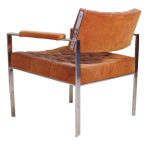Looking at Vintage Steel Furniture
Published on: By Gail Garlick

How long do viewers spend with a work of art? Most spend 15 to 30 seconds. But real seeing takes patience, time, developing your eye. What you see depends on what you know and what you’ve seen before. How long you look and how intensely, will alter what you see. Observing carefully is critical in evaluating a piece of furniture. Even after owning something for years I’ve made discoveries. Here are three chairs that are similar but not the same. Let’s look at them together. As you learn to slow down and regard what’s in front of you, you’ll see more details.
Chair one’s armrest wraps around its frame, its seat is a loose cushion upon an upholstered shell. Chair two’s armrest is inset into the length of its metal arm which creates a single plane of the armrest. Its seat cushion is tight, fitted into its metal frame. Chair three’s armrest sits on the top of its arm. Its seat cushion is tight without a frame. All are made of banded steel. One and three are chrome plated, two polished steel. Chair two’s steel arm and leg is 1/4 inch wider than number one and 1.25 inches wider than number three.
In chair one the upholstered shell extends forward of the frame. Also Its metal frame slants dramatically beyond the seat and back. In two the seat stays within the frame and with one band of steel running horizontally leg to leg under the seat and another set vertically from the top of the back ending at the horizontal bar beneath the seat. In one and two the back cushions terminate at the seat. In three the back stops short of the seat. Take a look at the side views. What makes one design more successful, another less so? Now you’re thinking like a dealer.
Chair one’s frame creates a box in back. The arms attach to its corners ending at the front legs. The frame’s extension beneath the seat, creates a rectangle which intersects the legs 2/3 of the way down. Chair two’s back and seat create a rectangle set between the legs that meet the arms. Chair three’s back is divided into two rectangles with an opening in between. It’s legs are configured like those in chair two but don’t seem nearly as dynamic. Ask yourself why. What creates the dynamism of chair two’s configuration?
Thanks for taking a moment to look. Happy Looking!
Warm regards,
Gail
P.S. Who made those chairs? One; Milo Baughman, Two; John Vesey, Three; Harvey Probber.


